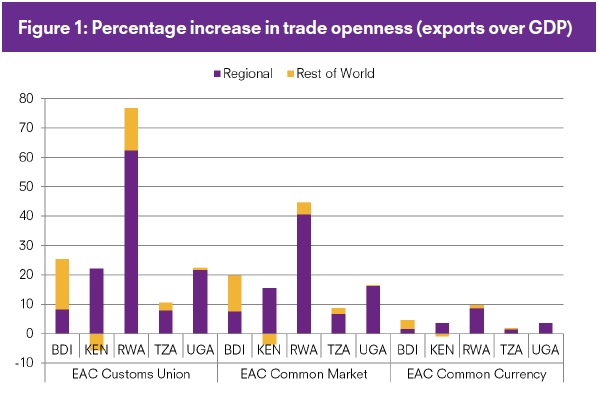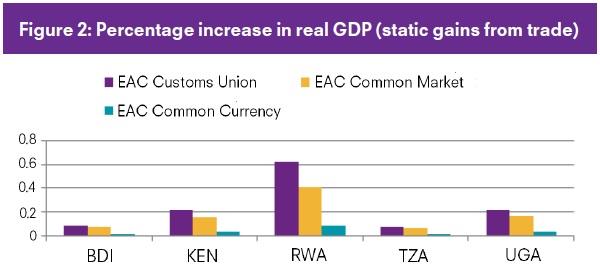News
Preferential Trade Arrangements and the pacification of Eastern Africa

Building on the most recent international trade theory and best practices of regional integration around the world, this study assesses the consequences of existing and prospective trade integration in the East African Community (EAC).
The paper uses the recent quantitative trade setup built around the structural micro-foundations for the gravity equation to evaluate the consequences of existing and prospective trade agreements between Eastern African Countries. The authors consider the economic gains that those agreements involve and, most important, their consequences on military conflict risks in the region, which the theory predicts to be ambiguous.
The gravity results point to large effects of those regional agreements in terms of trade creation. Using the structure of the model reveals diversion effects and welfare gains from the agreement that are modest, but in line with existing estimates of the literature. The political stability effects are more substantial, revealing that the main gains from African trade integration might be found in a pacifying effect in inter-state relations.
The authors also point to non-negligible post-agreement increase in the risk of internal conflicts, suggesting accompanying measures to prevent those detrimental effects to regional integration.
The authors show that:
-
The EAC customs union has been very successful in increasing bilateral trade among members, by 213% on average, much more than the Common Market for Eastern and Southern Africa (COMESA), which led to an increase of 80%, or the Southern African Development Community (SADC), which led to an increase of 110%.
-
The trade gains have translated in welfare improvements and stability. Real GDP is estimated to have risen by 0.45% in the EAC, and the statistical risk for bilateral conflicts between members decreased by 12% in response to the trade increase.
-
Efficient implementation of the EAC common market area is estimated to further double the gains in welfare achieved so far.
-
An EAC common currency is estimated to have only small trade and welfare effects that may not justify the risks and costs associated with it.
-
The estimated benefits from integration with COMESA and SADC are relatively small largely because the EAC already overlaps with both regional trade agreements, so the main value in the Tripartite Free Trade Area (TFTA) would lie in paving the way to a continental free trade area (FTA).
The EAC has been one of the most successful Regional Free Trade Areas in increasing trade
Beginning with a customs union between Kenya and Uganda in 1917, the EAC has had a long history of regional integration efforts. These efforts saw their first peak in the establishment of the first East African Community, which was comprised of a common market, currency and interregional infrastructure and institutions. The first EAC broke apart after ten years. In recognition of its benefits for economic growth and the potential to stabilise the region, Uganda, Kenya and Tanzania started a renewed effort of regional integration that led to the establishment of the current East African Community in 1999. A customs union was established in 2005, a common market in 2010, and a protocol for the establishment of a monetary union was signed in 2013. But progress to realise some of these commitments has been uneven, with the implementation of the common market behind schedule and the establishment of a monetary union up to the test of a convergence period and other hurdles. This slow-down in deeper integration reflects the wide disparities of economic and social situations between the member states as well as the legal and institutional complexities in operationalising the common market and currency. To some extent hesitation also stems from uncertainty about the potential benefits, which many perceive to be relatively small.
In their IGC working paper researchers Thierry Mayer (Sciences Po) and Mathias Thoenig (Université de Lausanne) address this uncertainty and provide quantitative estimates of the gains to be expected from deeper integration, in terms of increased trade, welfare, and stability. Starting with an analysis of the gains that have been achieved through EAC integration up to today, the study then evaluates the prospects of a full implementation of the common market and currency, as well as a full implementation of the Tripartite FTA between COMESA, SADC and EAC.
For their analysis the researchers compiled an extensive dataset covering trade flows and explanatory variables for the period 1949-2011. The data is first analysed using best-practice modern gravity regressions that allowed benchmarking of the trade gains of the universe of regional trade agreements covered in the sample period (using over 1 million observations).
Results from the gravity regressions show that up to the year 2011, the EAC had already increased bilateral trade between two member states by an estimated 213% with respect to a counterfactual situation without the EAC. This makes the EAC one of the most successful Free Trade Areas in Africa – and even in the world. It has increased bilateral trade between member countries by an estimated 121% more than the other regional trade agreements covered in the sample. The regressions also show that the generalised system of preference agreements with the EU and the US have made only marginal contributions to African exports.
An EAC common market promises much higher returns than a common currency
Building on the results from the gravity regressions, the researchers next use a state-of-the-art simulation tool to estimate the effects of deepened integration in the EAC. The model allows computation of the expected gains in trade, increase in real GDP, as well as the effect on the risks of inter- and intra-state conflict (based on the computed changes in trade shares). The simulation uses the trade patterns observed in the year 2009 as baseline.
The results of this simulation are shown in figures 1 and 2. The first figure summarises the expected percentage increases of EAC member countries’ trade openness (exports over GDP) in response to a full implementation of the common market and the monetary union. To provide a basis for comparison, the figures include estimates of the gains achieved through membership in the EAC customs union. This comparison case rests on a simulation of the trade patterns in 2009 without the EAC customs union.
Gains in trade openness
The simulation shows that the gains in trade openness to be expected from the common market are large, albeit somewhat smaller than the estimated gains from the customs union (+14% vs +18% respectively for the EAC as a whole).The trade gains to be expected from the common currency are much smaller (+3%). In line with expectation, the smaller land-locked countries Burundi and Rwanda have most to gain, with Uganda and Kenya on par, but ahead of Tanzania. Most gains in trade stem from increased regional trade, induced by lower trade costs (lower tariffs in the case of a common market, and lower transaction costs in the case of a common currency) and higher competition that leads to better quality, quantity and variety of products becoming available within the EAC.

(Static) Gains in welfare
A similar picture emerges when comparing the simulated impact of a common market and currency on welfare, measured in the percentage increase in real GDP in Figure 2. It is important to note that these are estimates of the static gains from trade. Static gains from trade are estimates of the real GDP increase resulting from the exploitation of cost-differentials, or comparative advantage that the new trade relations in the common market or currency area imply. Static gains from trade do not take into account further dynamic gains in the rate of economic growth to be expected as a result of increasing firm productivity caused by regional value chain upgrading, increased investment rates, access to more efficient intermediate inputs, or learning from international firms.
Static gains from the creation of a common market are estimated to be +0.42% of real GDP vs +0.45% gains estimated for the customs union. The welfare impact of the common currency is estimated to be much smaller, at 0.1% of GDP. Comparing member countries, it is Rwanda who stands to realise the highest welfare gains from further integration, followed by Kenya and Uganda. Because Burundi’s current level of trade openness is lowest in the EAC, the country will likely gain comparatively little in real GDP, despite a possibly strong expansion in trade. While these numbers might appear low, the estimates are in line with the existing quantitative literature that measures static gains from trade. The total gains from trade including dynamic gains can be expected to be considerably higher, but computation of these is beyond the scope of this paper.





